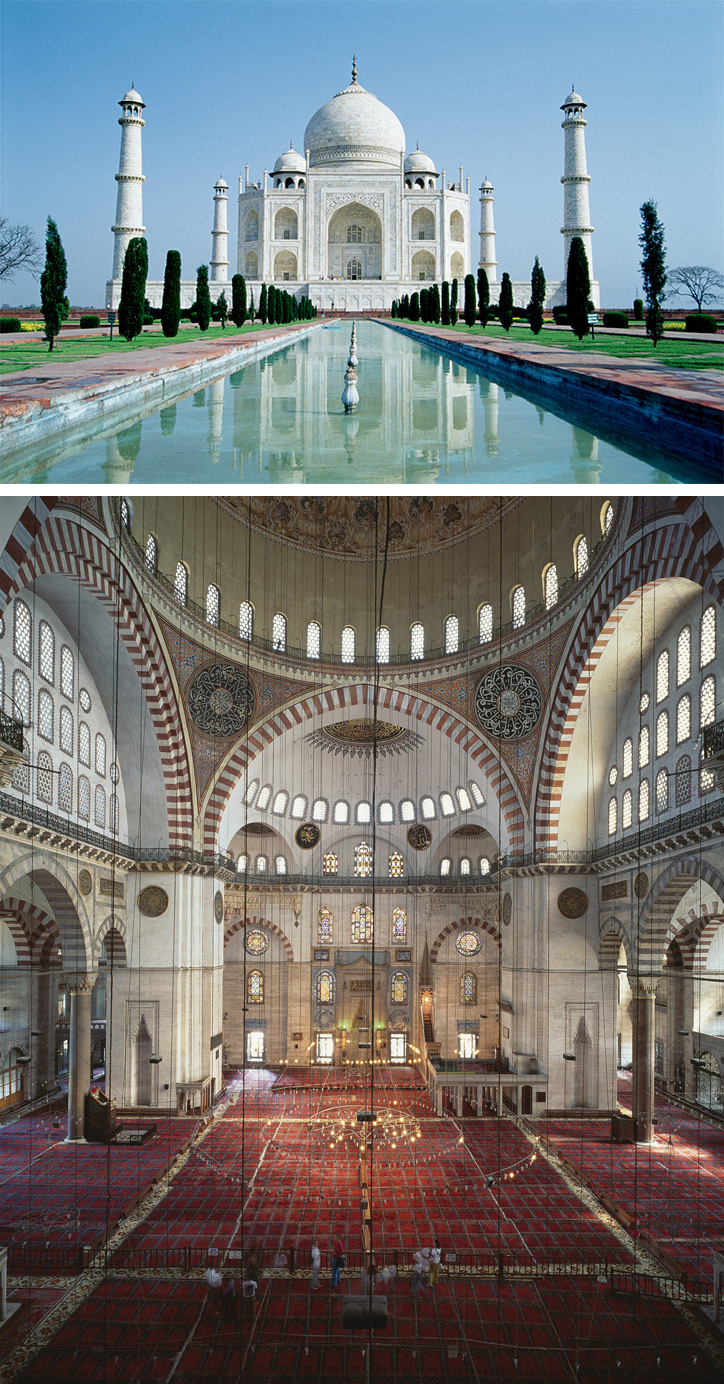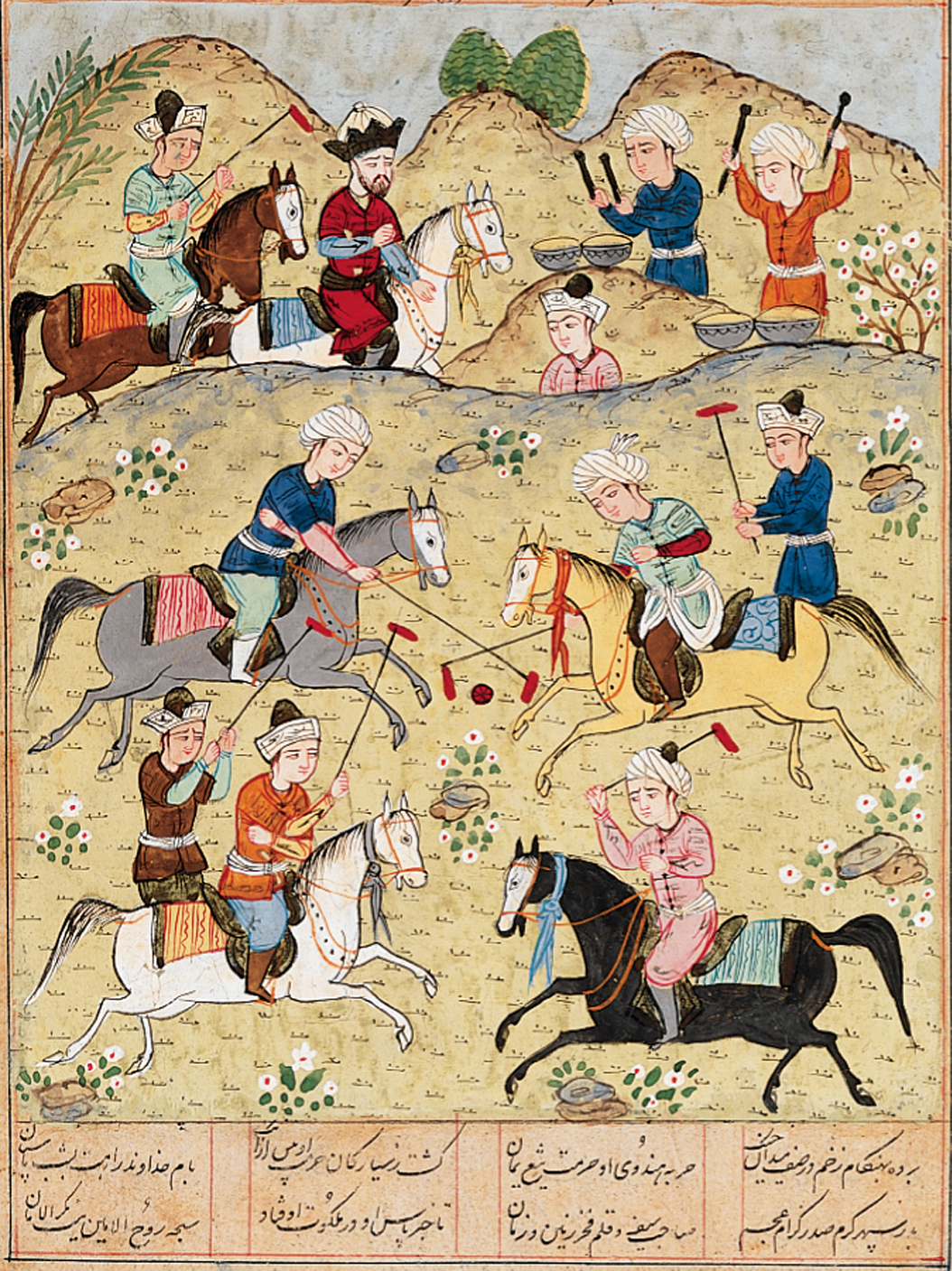City and Palace Building
In all three empires strong rulers built capital cities and imperial palaces as visible expressions of dynastic majesty. Europeans called Suleiman “the Magnificent” because of the grandeur of his court. With annual state revenues of about $80 million (at a time when Elizabeth I of England could expect $150,000 and Francis I of France perhaps $1 million) and thousands of servants, he had a lifestyle no European monarch could begin to rival. He used his fabulous wealth to adorn Istanbul with palaces, mosques, schools, and libraries, and the city reached about a million in population. The building of hospitals, roads, and bridges and the reconstruction of the water systems of the great pilgrimage sites at Mecca and Jerusalem benefited his subjects. Safavid Persia and Mughal India produced rulers with similar ambitions.
The greatest builder under the Ottomans was Mimar Sinan (1491–1588), a Greek-born devshirme recruit who rose to become imperial architect under Suleiman. A contemporary of Michelangelo, Sinan designed 312 public buildings, including mosques, schools, hospitals, public baths, palaces, and burial chapels. His masterpieces, the Shehzade and Suleimaniye Mosques in Istanbul, which rivaled the Byzantine church of Hagia Sophia, were designed to maximize the space under the dome. His buildings expressed the discipline, power, and devotion to Islam that characterized the Ottoman Empire under Suleiman.

Two Masterpieces of Islamic Architecture Istanbul’s Suleimaniye Mosque, designed by Sinan and commissioned by Suleiman I, was finished in 1557. Its interior (bottom) is especially spacious. The Taj Mahal (top), built about a century later in Agra in northern India, is perhaps the finest example of Mughal architecture. Its white marble exterior is decorated with Arabic inscriptions and floral designs. (mosque: Belinda Images/SuperStock; Taj Mahal: Dinodia/The Bridgeman Art Library)
Shah Abbas made his capital, Isfahan, the jewel of the Safavid Empire. He had his architects place a polo ground in the center and surrounded it with palaces, mosques, and bazaars. A seventeenth-century English visitor described one of Isfahan’s bazaars as “the surprisingest piece of Greatness in Honour of commerce the world can boast of.” In addition to splendid rugs, stalls displayed pottery and fine china, metalwork of exceptionally high quality, and silks and velvets of stunning weave and design. A city of perhaps 750,000 people, Isfahan also contained 162 mosques, 48 schools where future members of the ulama learned the sacred Muslim sciences, 273 public baths, and the vast imperial palace. Mosques were richly decorated with blue tile. Private houses had their own garden courts, and public gardens, pools, and parks adorned the wide streets. Tales of the beauty of Isfahan circulated worldwide, attracting thousands of tourists annually in the seventeenth and eighteenth centuries.

Isfahan Tiles The embellishment of Isfahan under Shah Abbas I created an unprecedented need for tiles, as had the rebuilding of imperial Istanbul after 1453, the vast building program of Suleiman the Magnificent, and a huge European demand. Persian potters learned their skills from the Chinese. By the late sixteenth century Italian and Austrian potters had imitated the Persian and Ottoman tile makers. (Eileen Tweedy/Victoria & Albert Museum, London, UK/The Art Archive at Art Resource, NY)
Akbar in India was also a great builder. The birth of a long-awaited son, Jahangir, inspired Akbar to build a new city, Fatehpur Sikri, to symbolize the regime’s Islamic foundations. He personally supervised the construction of the city, which combined the Muslim tradition of domes, arches, and spacious courts with the Hindu tradition of flat stone beams, ornate decoration, and solidity. The historian Abu’l-Fazl reported, “His Majesty plans splendid edifices, and dresses the work of his mind and heart in the garment of stone and clay.”3 Completed in 1578, the city included an imperial palace, a mosque, lavish gardens, and a hall of worship, as well as thousands of houses for ordinary people. Unfortunately, because of its bad water supply, the city was soon abandoned.
Of Akbar’s successors, Shah Jahan had the most sophisticated interest in architecture. Because his capital at Agra was cramped, in 1639 he decided to found a new capital city at Delhi. In the design and layout of the buildings, Persian ideas predominated, an indication of the number of Persian architects and engineers who had flocked to the subcontinent. The walled palace-fortress alone extended over 125 acres. Built partly of red sandstone, partly of marble, it included private chambers for the emperor; mansions for the wives, widows, and concubines of the imperial household; huge audience rooms for the conduct of public business (treasury, arsenal, and military); baths; and vast gardens filled with flowers, trees, and thirty silver fountains spraying water. In 1650, with living quarters for guards, military officials, merchants, dancing girls, scholars, and hordes of cooks and servants, the palace-fortress housed fifty-seven thousand people. It also boasted a covered public bazaar. The sight of the magnificent palace left contemporaries speechless. Shah Jahan had a Persian poetic couplet inscribed on the walls:
If there is a paradise on the face of the earth,
Beyond the walls, princes and aristocrats built mansions and mosques on a smaller scale. With its fine architecture and its population of between 375,000 and 400,000, Delhi gained the reputation of being one of the great cities of the Muslim world.
For his palace, Shah Jahan ordered the construction of the Peacock Throne. This famous piece, encrusted with emeralds, diamonds, pearls, and rubies, took seven years to fashion and cost the equivalent of $5 million. It served as the imperial throne of India until 1739, when the Persian warrior Nadir Shah seized it as plunder and carried it to Persia.
Shah Jahan’s most enduring monument is the Taj Mahal. Between 1631 and 1648 twenty thousand workers toiled over the construction of this memorial in Agra to Shah Jahan’s favorite wife, who died giving birth to their fifteenth child. One of the most beautiful structures in the world, the Taj Mahal is both an expression of love and a superb architectural blending of Islamic and Indian culture.

Polo Two teams of four on horseback ride back and forth on a grass field measuring 200 by 400 yards, trying to hit a 4½-ounce wooden ball with a 4-foot mallet through the opponent’s goal. Because a typical match involves many high-speed collisions among the horses, each player has to maintain a string of expensive ponies in order to change mounts several times during the game. Students of the history of sports believe the game originated in Persia, as shown in this eighteenth-century miniature, whence it spread to India, China, and Japan. Brought from India to England, where it became very popular among the aristocracy in the nineteenth century, polo is a fine example of cross-cultural influences. (Private Collection)


